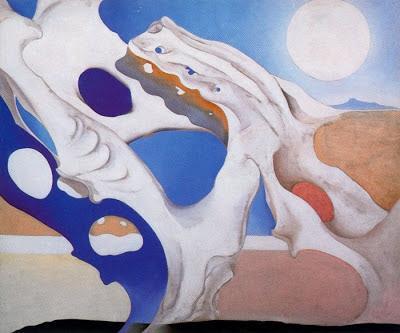
Shadow with Pelvis and Moon by Georgia O'Keeffe*
Because we had a question from a reader about pelvic congestion and I’m not knowledgeable about this topic, I turned to our regular contributor Shelly Prosko, physical therapist and yoga teacher, who has expertise working with pelvic health. Here’s my interview with her:Baxter: Can you tell us a bit about this condition, the symptoms associated with it, and underlying causes?
Shelly: Pelvic Congestion Syndrome (PCS) is a condition in both men and women that is characterized by varicose veins in the pelvic region. Basically, the veins that bring blood back to the heart from your pelvic organs become enlarged, perhaps because the walls have less integrity and/or the valves inside the veins become less effective at directing blood flow. This results in pooling of the blood and can sometimes (but not always) result in pain in the pelvic, lower abdominal, genital, hip, or low back regions. Pain can be worsened during intercourse, orgasm, menstruation, erection, urination, or defecation, pregnancy, from prolonged standing or sitting, or at the end of the day. Often there is a sensation of “heaviness” or pressure inside the pelvis or on the pelvic floor, similar to sensations felt pelvic organ prolapse.
These varicose veins can also be present in the perineum, genitals, and rectum, and can be a cause of hemorrhoids. Pelvic Congestion Syndrome can affect pelvic floor muscle function and may disrupt the roles the pelvic floor muscles play in bowel, bladder, reproduction, and sexual function, hip function, and our core stability system (see Optimizing Pelvic Floor Health Through Yoga Therapy).
The underlying cause of why the walls and valves of pelvic veins start to malfunction in Pelvic Congestion Syndrome can vary and are not always known. Risk factors include: genetics, pregnancy, sedentary lifestyle, obesity, trauma to veins, and hormonal changes.
Baxter: How do you address pelvic congestion with yoga? And what kinds of results have you observed?
Shelly: I’d like to remind the readers that as with any condition addressing pelvic congestion with yoga is not “yoga for the condition,” rather, it is yoga is for “you,” the individual. What works well for one individual with Pelvic Congestion Syndrome may not be suitable for you. That said, here are some general suggestions that may have a positive impact on many of the symptoms that result from this condition:
1. Yoga techniques for reducing the pain experience and improving pain management can be helpful. The blog post “Yoga for Pain Management: The Big Picture” covers a great deal.
2. The yoga techniques I described in “Organ Prolapse and Yoga” blog post can also be helpful for Pelvic Congestion Syndrome because of some of the similarities of what we are trying to achieve in each condition (reduce intra-abdominal pressure and reduce downward gravitational force).
3. The recommendations you provided in the post for varicose veins in the legs may also be useful for people suffering from Pelvic Congestion Syndrome, with the addition of elevating the pelvis slightly higher than the heart when in inverted poses, such as Legs Up the Wall pose (Viparita Karani). Incorporating muscle pumping’ action in the lower extremities during the inversions could be useful as you mentioned. In addition to ankle pumps, you can write the “alphabet” with your foot, or write a love letter to yourself! You can also perform pumping actions of different muscle groups, including:
- Quad sets (tighten the muscles of front thigh by straightening the knees then relax)
- Hamstring sets (dig heel into the wall, then relax)
- Glut sets (gently squeeze buttocks together, then relax)
- Pelvic floor muscle sets (PFM sets), but only if you have had proper instruction from a pelvic floor physical therapist who can ensure you are performing them correctly. Research shows that many people do not perform a pelvic floor muscle contraction (Kegel) correctly, and can do more harm than good and worsen their condition by bearing down or increasing pressure or exacerbating pain.
For example, during a supported inverted pose, such as Legs Up the Wall pose or Supported Bridge Pose, you could practice three- or four- part breath. Four-part breath is similar to three-part, but with you divide your trunk into four parts, adding in the breath filling the “pelvic bowl” compartment (visualizing pelvic floor muscles descending upon inhalation).
I also have several resources (videos and articles) that explain and demonstrate the pelvic diaphragmatic breath pattern in supportive yoga poses, as well as in timing with gentle dynamic movement that could potentially enhance blood flow in the pelvic region. Here is my YouTube video that demonstrates Legs Up the Wall (Viparita Karani) with the pelvis and hips elevated in a unique way to enhance circulation, lymphatic drainage and full pelvic floor movement.
Pelvic Congestion Syndrome is often under-diagnosed. I have not had many patients come to see me specifically with that medical diagnosis. However, many of my patients suffering from pelvic pain conditions, pelvic organ prolapse, and circulation problems have responded favorably to the above suggestions, in conjunction with pain science education and following the pain care yoga guidelines we discussed in a previous post. My colleagues Becki Meehan and Pat Salin Huston, both board certified women’s health physical therapists and professional yoga therapists, have found positive results with supported inversions, muscle pumping, and manual lymphatic drainage methods with their patients suffering from pelvic congestion syndrome.
Baxter: Thanks so much for this helpful information, Shelly. I’ll be writing on Friday about varicose veins and we’ll have some discussion then about the relationship between varicose veins and Pelvic Congestion Syndrome.
CAUTION: The content in this article is not intended for medical advice. Please ensure you seek approval and advice from your health care practitioner before attempting any of the methods in this article or corresponding videos.

Shelly has been integrating yoga into her physical therapy treatments since 1998, addressing a wide variety of conditions including persistent pain. Currently, she travels globally offering specialty PhysioYoga and Life is Now PCY courses, lecturing at medical college programs, instructing at numerous therapeutic yoga programs, and presenting at international conferences. She is dedicated to actively promoting the integration of yoga into healthcare by inspiring, empowering, and educating health professionals, yoga practitioners, students, and people in pain about ways yoga can be used safely and effectively to address a variety of health issues and improve quality of life. Please visit www.physioyoga.ca for more information.
Subscribe to Yoga for Healthy Aging by Email ° Follow Yoga for Healthy Aging on Facebook ° Join this site with Google Friend Connect

